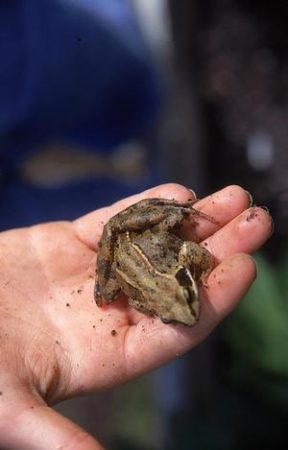Post category: Pests
Barrier methods of pest control consist of physically separating the pest from its food source. They are the most effective and health-safe way of dealing with a pest problem. The pest may be actually removed physically from the vicinity of the food plant, as in removing snails near young plants or picking caterpillars off cabbage; or the pest may be excluded by netting or by fencing. Scaring may be effective too.
Physical control does not interfere with natural control systems which is a major advantage. It may be more costly and time-consuming than chemical control but there are no residues to consider. The removal of old crops and debris that harbour pests is an important part of physical control, as is early digging to expose over-wintering pests to the weather, and to predators.
Suitable barrier methods of pest control are given for each kind of pest.
Plants are food for many types of animal – from microscopic eelworms to large mammals – but very few of these could be called pests.

Wasps are both pest and beneficial predator
Unless an animal causes damage great enough to destroy the feature for which the plant is grown, it cannot be termed a pest. Examples of a pest species include: carrot root fly maggots that bore in the roots of carrots, making them useless; codling moth grubs that feed inside apples causing them to fall prematurely; greenflies, which by their presence, render lettuce inedible.
The simplest way to solve a particular pest problem is not to grow the pest’s food plant, but, if it is decided to grow the plants, and there are pests in the vicinity, control measures may be necessary.
Plants are not totally helpless against pests – they have their own defence mechanisms. The most obvious ones are thorny leaves or stems to deter grazing animals. A scaled-down versions of these are hairy plant stems, for instance, some plant hairs can be quite sharp and cause skin irritation.

Ragwort is posionous
Other plants, such as butterfly flower and petunia, have sticky plant hairs that act as miniature fly traps, making difficult the passage of greenflies and other small insects. Some plants rely on being unpalatable or poisonous. For example, plants with milky sap do not seem to suffer so much from greenflies, and the well-known insecticides – derris, pyrethrum, nicotine and quassia are all of plant origin.
Even common plants have ways of dissuading feeding animals – rhubarb is a strong laxative, the leaves containing large quantities of poisonous oxalic acid. Ragwort, bracken and yew are poisonous to grazing animals. Laburnum, daphne, cotoneaster, laurel and monkshood are examples of cultivated plants that are poisonous to a greater or lesser degree.
Pests have their own ‘pests’ in the form of predators and parasites. Predators are usually large and fast moving, killing and eating the pest species. Obvious examples are birds, bats, hedgehogs, field mice, frogs and foxes, which dispose of considerable numbers of insects and other pests.

Shield bugs kill caterpillars
Less well-known are the insect predators, which include ladybirds, lacewings, ground beetles, hoverflies, capsid bugs, spiders and earwigs. Most of these live off greenflies, suckers, leaf-hoppers and red spider mites.
Parasites are usually smaller than the insect they parasitise, and the pest is usually kept alive for some time before eventually dying. Many kinds of tiny flies, wasps and midges parasitise the eggs and larvae of pest species, especially greenflies and caterpillars.
Pests are attacked by diseases that play an important role in limiting their populations. For example, myxomatosis disease greatly reduced the rabbit population, although rabbit numbers have recovered considerably.
Nature tends towards balance. If because of favourable weather, huge numbers of a pest appear, and plant defences are overwhelmed, there are two consequences. The plants under attack fail to produce as much seed, so there will be fewer plants the following year. This means less food for the pest, causing numbers to decrease.

Frogs eat slugs
At the same time, the predators and parasites would quickly increase in numbers, there being a large population of pests to feed off. In time, the two factors would bring pest numbers back to the former level.
Natural pest control could be largely relied upon if the garden had only wild plants and wild habitat. In a garden of cultivated plants, artificial plant populations are created. Plants are grown in groups or rows, inviting pest attack.
Weeds and debris are removed, destroying the shelter of predators. A garden is an artificial situation and natural balancing systems will generally not get it right, unaided. However, the natural systems go a long way towards keeping the balance right.
Correct pest control in the garden should concentrate on encouraging, or at least not damaging, the natural systems. Only if the natural control systems prove inadequate, because of the artificiality of the garden, should they be assisted by physical or chemical control methods.
Chemical control consists of killing the pest with chemical poisons. It appears to be a simple solution to pest problems but there are serious disadvantages – chemicals getting onto plants may damage them or leave residues on a food crop. Harmless, potentially beneficial insects might be killed.
To make chemical control safer and more acceptable, the chemicals nowadays offered for sale are less poisonous and less persistent, meaning it is less likely there will be residues and, if there are, they will be less dangerous. Chemical control is cheap and easy – perhaps too easy.
Because of the disadvantages, chemical control should be used only when there is no other solution. Routine spraying is to be avoided, unless absolutely necessary, because it leaves excess residues, damages the natural balance and encourages the evolution of resistant strains of the pest. Not only is unnecessary spraying a waste of time but it can be very counterproductive.


